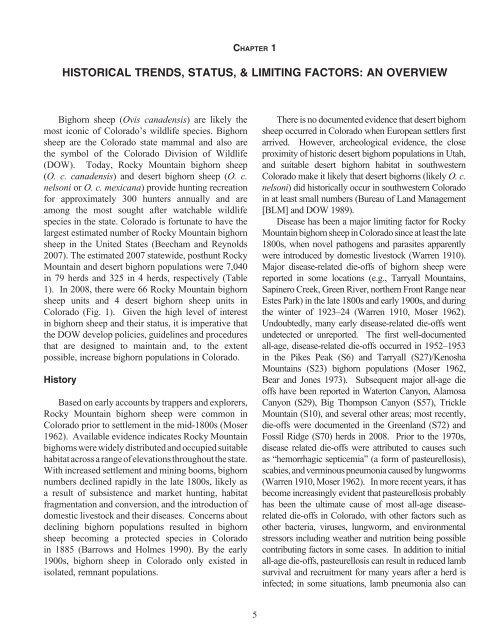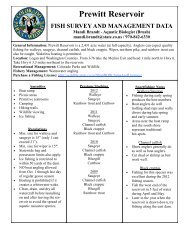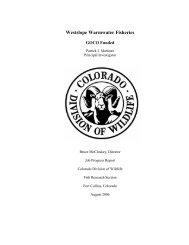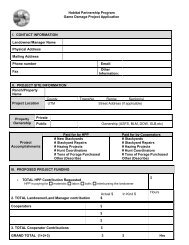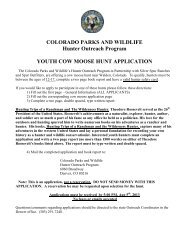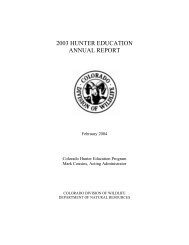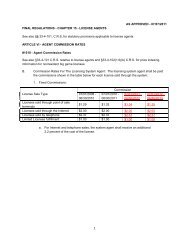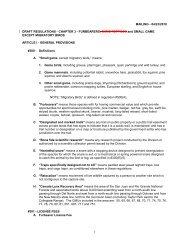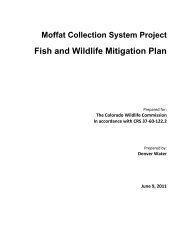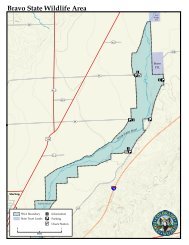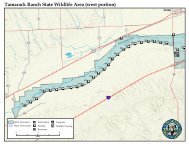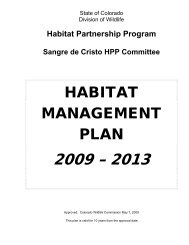COLORADO BIGHORN SHEEP MANAGEMENT PLAN 2009−2019
COLORADO BIGHORN SHEEP MANAGEMENT PLAN 2009−2019
COLORADO BIGHORN SHEEP MANAGEMENT PLAN 2009−2019
Create successful ePaper yourself
Turn your PDF publications into a flip-book with our unique Google optimized e-Paper software.
Chapter 1<br />
HISTORICAL TRENDS, STATUS, & LIMITING FACTORS: AN OVERVIEW<br />
Bighorn sheep (Ovis canadensis) are likely the<br />
most iconic of Colorado’s wildlife species. Bighorn<br />
sheep are the Colorado state mammal and also are<br />
the symbol of the Colorado Division of Wildlife<br />
(DOW). Today, Rocky Mountain bighorn sheep<br />
(O. c. canadensis) and desert bighorn sheep (O. c.<br />
nelsoni or O. c. mexicana) provide hunting recreation<br />
for approximately 300 hunters annually and are<br />
among the most sought after watchable wildlife<br />
species in the state. Colorado is fortunate to have the<br />
largest estimated number of Rocky Mountain bighorn<br />
sheep in the United States (Beecham and Reynolds<br />
2007). The estimated 2007 statewide, posthunt Rocky<br />
Mountain and desert bighorn populations were 7,040<br />
in 79 herds and 325 in 4 herds, respectively (Table<br />
1). In 2008, there were 66 Rocky Mountain bighorn<br />
sheep units and 4 desert bighorn sheep units in<br />
Colorado (Fig. 1). Given the high level of interest<br />
in bighorn sheep and their status, it is imperative that<br />
the DOW develop policies, guidelines and procedures<br />
that are designed to maintain and, to the extent<br />
possible, increase bighorn populations in Colorado.<br />
History<br />
Based on early accounts by trappers and explorers,<br />
Rocky Mountain bighorn sheep were common in<br />
Colorado prior to settlement in the mid-1800s (Moser<br />
1962). Available evidence indicates Rocky Mountain<br />
bighorns were widely distributed and occupied suitable<br />
habitat across a range of elevations throughout the state.<br />
With increased settlement and mining booms, bighorn<br />
numbers declined rapidly in the late 1800s, likely as<br />
a result of subsistence and market hunting, habitat<br />
fragmentation and conversion, and the introduction of<br />
domestic livestock and their diseases. Concerns about<br />
declining bighorn populations resulted in bighorn<br />
sheep becoming a protected species in Colorado<br />
in 1885 (Barrows and Holmes 1990). By the early<br />
1900s, bighorn sheep in Colorado only existed in<br />
isolated, remnant populations.<br />
5<br />
There is no documented evidence that desert bighorn<br />
sheep occurred in Colorado when European settlers first<br />
arrived. However, archeological evidence, the close<br />
proximity of historic desert bighorn populations in Utah,<br />
and suitable desert bighorn habitat in southwestern<br />
Colorado make it likely that desert bighorns (likely O. c.<br />
nelsoni) did historically occur in southwestern Colorado<br />
in at least small numbers (Bureau of Land Management<br />
[BLM] and DOW 1989).<br />
Disease has been a major limiting factor for Rocky<br />
Mountain bighorn sheep in Colorado since at least the late<br />
1800s, when novel pathogens and parasites apparently<br />
were introduced by domestic livestock (Warren 1910).<br />
Major disease-related die-offs of bighorn sheep were<br />
reported in some locations (e.g., Tarryall Mountains,<br />
Sapinero Creek, Green River, northern Front Range near<br />
Estes Park) in the late 1800s and early 1900s, and during<br />
the winter of 1923–24 (Warren 1910, Moser 1962).<br />
Undoubtedly, many early disease-related die-offs went<br />
undetected or unreported. The first well-documented<br />
all-age, disease-related die-offs occurred in 1952–1953<br />
in the Pikes Peak (S6) and Tarryall (S27)/Kenosha<br />
Mountains (S23) bighorn populations (Moser 1962,<br />
Bear and Jones 1973). Subsequent major all-age die<br />
offs have been reported in Waterton Canyon, Alamosa<br />
Canyon (S29), Big Thompson Canyon (S57), Trickle<br />
Mountain (S10), and several other areas; most recently,<br />
die-offs were documented in the Greenland (S72) and<br />
Fossil Ridge (S70) herds in 2008. Prior to the 1970s,<br />
disease related die-offs were attributed to causes such<br />
as “hemorrhagic septicemia” (a form of pasteurellosis),<br />
scabies, and verminous pneumonia caused by lungworms<br />
(Warren 1910, Moser 1962). In more recent years, it has<br />
become increasingly evident that pasteurellosis probably<br />
has been the ultimate cause of most all-age diseaserelated<br />
die-offs in Colorado, with other factors such as<br />
other bacteria, viruses, lungworm, and environmental<br />
stressors including weather and nutrition being possible<br />
contributing factors in some cases. In addition to initial<br />
all-age die-offs, pasteurellosis can result in reduced lamb<br />
survival and recruitment for many years after a herd is<br />
infected; in some situations, lamb pneumonia also can


